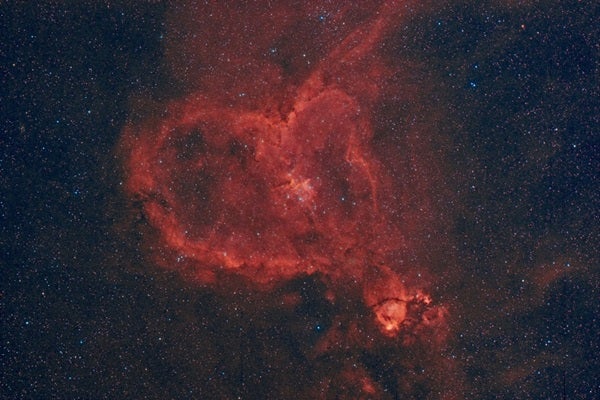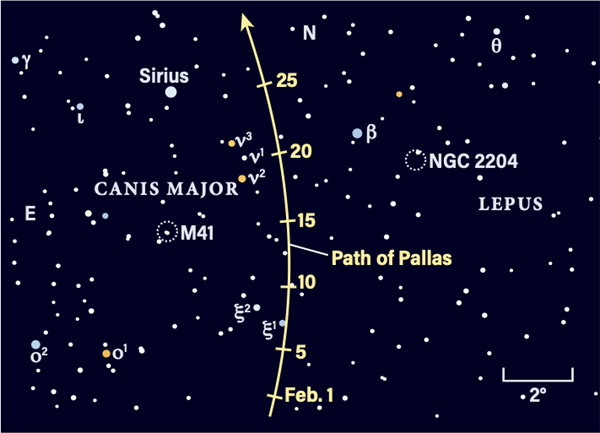Friday, February 10
Jupiter’s Galilean moons orbit in a plane close to the planet’s equator. This means we generally see them east and west of the planet, or crossing directly over its face. But the tilt of the system relative to our line of sight here on Earth can sometimes cause strange effects — such as the sight of Callisto sitting due north of its fellow moon Ganymede this evening.
Callisto is moving from west to east, while Ganymede is traveling in the opposite direction. The two moons appear to line up perfectly just east of the planet around 10 P.M. EST, with Callisto 30″ north of Ganymede. Io and Europa sit to Jupiter’s west, with the former closer to the limb. At that time, magnitude –2.2 Jupiter is very low in the Midwest, a mere 3° above the western horizon as it sinks amid the stars of Cetus and Pisces. The planet appears higher (and better) for those farther west.
For those on the East Coast, you can catch the preshow: Around 9 P.M. EST, Callisto appears just northwest of Ganymede, with roughly 30″ still separating the two.
Sunrise: 6:59 A.M.
Sunset: 5:30 P.M.
Moonrise: 10:27 P.M.
Moonset: 9:23 A.M.
Moon Phase: Waning gibbous (79%)
*Times for sunrise, sunset, moonrise, and moonset are given in local time from 40° N 90° W. The Moon’s illumination is given at 12 P.M. local time from the same location.
Saturday, February 11
At this time of year, the zodiacal light shines above the western horizon after sunset. This soft glow is generated by sunlight scattering off dust in the inner solar system, largely left by myriad comets, as well as asteroid collisions. Over time, this dust settles into orbit around the Sun in the plane of the solar system, called the ecliptic. This is the path the Sun appears to take through Earth’s sky, along which lie the constellations of the zodiac.
Because the zodiacal light is relatively faint and diffuse, the best time to view it is in a moonless sky. Fortunately for us, the Moon doesn’t rise until nearly midnight tonight, leaving the evening sky clear of its glare. You’ll want an observing site far from as much artificial lighting as possible, particularly streetlights. If you can get to a higher elevation, all the better. About an hour after the Sun disappears, look west — the ecliptic is nearly perpendicular to the horizon right now, rising through Aquarius and up into Pisces, just to the right of bright Venus (closer to the horizon) and Jupiter (farther up in the sky). The zodiacal light should remain visible for roughly another hour, brightest at the horizon and dimming as it narrows into a spike higher up.
Sunrise: 6:58 A.M.
Sunset: 5:31 P.M.
Moonrise: 11:33 P.M.
Moonset: 9:46 A.M.
Moon Phase: Waning gibbous (70%)
Sunday, February 12
Asteroid 2 Pallas reaches its stationary point amid the background stars at 3 P.M. EST. The magnitude 7.7 main-belt world lies in Canis Major, rising in the southeast at sunset. A few hours later, Pallas is 25° high in the south, to the lower right of the blazing luminary Sirius, the Dog Star. The asteroid lies some 6° southwest of Sirius and 4° southwest of Mirzam (magnitude 2 Beta [β] Canis Majoris).
Nearby is another treat: Some 3.5° east-northeast of Pallas is M41. This young open cluster is roughly magnitude 4.5 — visible to the naked eye under dark conditions. It lies 4° south of Sirius and stretches nearly 40′ wide. With an estimated age of just over 200 million years, M41 is home to around 100 stars. It’s best viewed at low power; you might even use binoculars to catch it together with Pallas in the sky.
Sunrise: 6:57 A.M.
Sunset: 5:32 P.M.
Moonrise: —
Moonset: 10:11 A.M.
Moon Phase: Waning gibbous (60%)
Monday, February 13
Last Quarter Moon occurs at 11:01 A.M. EST. Our satellite now dominates the early-morning sky, remaining visible well after sunrise.
Comet C/2022 E3 (ZTF) is dropping through richly appointed Taurus, offering a plethora of stellar delights to view alongside the comet’s green glow. You’ll find the constellation high in the southwest after dark, with bright Mars (magnitude 0.1) to the upper right of the Bull’s red giant eye, magnitude 0.9 Aldebaran.
After passing closest to Earth nearly two weeks ago, ZTF is fading; it’s recently been recorded around mid-6th magnitude and will continue to grow fainter over time. Still, that’s bright enough to easily catch in binoculars or a small scope; tonight, it’s located about 6.6° due south of Mars and 2.5° northeast of Aldebaran. Nearby are several stunning deep-sky objects, including open clusters NGC 1746 and NGC 1817 to the east, as well as the nebulae NGC 1554 and 1555 and the widely scattered stars of the Hyades to the west. Astroimagers will likely want to capture at least a few wide-field shots in addition to any closeups of the comet.
Sunrise: 6:55 A.M.
Sunset: 5:34 P.M.
Moonrise: 12:41 A.M.
Moonset: 10:41 A.M.
Moon Phase: Waning crescent (49%)
Tuesday, February 14
Venus sidles up to Neptune in the evening twilight as the planets prepare for tomorrow’s conjunction. An hour after sunset, the pair is 13.5° high in the west, with Venus impossible to miss at magnitude –3.9. Look with binoculars to find faraway Neptune, magnitude 7.8, about 33′ northeast of Venus’ bright gibbous disk. If you can’t spot the ice giant just yet, wait a little longer for the sky to grow darker. Within the next 24 hours, Venus will first cross due south of Neptune, then appear northeast of the distant planet by evening. We’ll return tomorrow for another look.
Once the sky grows a little darker still, celebrate Valentine’s Day with a view of the stunning red Heart Nebula in Cassiopeia. The constellation sits to the upper left of the Little Dipper in the north this evening. The Heart Nebula, also cataloged as IC 1805, is a magnitude 6.5 emission nebula just under 5° east-southeast of magnitude 3.4 Epsilon (ε) Cassiopeiae. It’s best viewed with a larger (8-inch or more) telescope, though you can use low or high magnification to bring out different aspects of its structure. A nebula filter will further enhance the view. Look particularly for NGC 896, a bright knot of glowing gas and dust that sits southwest of the Heart proper and is a little easier to see than the larger, fainter nebula. You can also find NGC 1027, a 7th-magnitude star cluster, just over 1° east of the Heart.
Sunrise: 6:54 A.M.
Sunset: 5:35 P.M.
Moonrise: 1:53 A.M.
Moonset: 11:19 A.M.
Moon Phase: Waning crescent (38%)
Wednesday, February 15
Venus passes 0.01° south of Neptune at 7 A.M. EST this morning. Let’s return to the pair in the evening sky to see how the view has changed since yesterday.
An hour after sunset, Venus is now some 35′ northeast of Neptune as the former travels quickly along the ecliptic. Both planets will still fit into the same telescopic or binocular field of view, with tiny, 2″-wide Neptune popping out as the sky grows darker. The ice giant will look like a small, round, “flat” star colored bluish-gray. Meanwhile, Venus’ bright disk is nearly 90 percent lit and spans 12″, six times as wide as Neptune. Venus is much smaller than Neptune in reality, of course, but its much closer proximity makes it appear significantly larger in our sky.
Tonight, Venus sits right on the border between Pisces and Aquarius; the planet will have moved firmly into Pisces by tomorrow. Neptune is following at a more sedate pace and won’t make the border crossing into Pisces until March 4.
Sunrise: 6:53 A.M.
Sunset: 5:36 P.M.
Moonrise: 3:05 A.M.
Moonset: 12:07 P.M.
Moon Phase: Waning crescent (28%)
Thursday, February 16
Saturn is in conjunction with the Sun at 12 P.M. EST, rendering it invisible for the rest of February. However, the ringed planet will make its reappearance in the morning sky next month.
If you’ve been observing Venus and Neptune for the past two nights, you’re already familiar with the region of sky we’ll be visiting tonight. Again, look west after sunset and you’ll see the large figure of Cetus the Whale stretching above the horizon. This time, we’re focusing east (to the upper right) of the planets to zero in on an excellent target for small scopes: the galaxy M77.
Spanning about 7′ by 6′, this slightly elongated spiral glows at 9th magnitude. You can find M77 by sliding a mere 0.9° east of 4th-magnitude Delta (δ) Ceti. M77 is an excellent example of an active galaxy, whose central supermassive black hole is greedily gobbling up material. However, the black hole’s accretion disk is not so bright that it outshines the galaxy, as happens with quasars. Instead, M77 is classified as a Seyfert galaxy, whose center shows indications of a feeding black hole without overpowering the light from its host. The galaxy’s center is visually bright largely because of the abundance of stars there, with fainter spiral arms visible through larger scopes.
Sunrise: 6:52 A.M.
Sunset: 5:37 P.M.
Moonrise: 4:15 A.M.
Moonset: 1:08 P.M.
Moon Phase: Waning crescent (18%)
Friday, February 17
Early this morning, a delicate crescent Moon sits near the Teapot asterism in Sagittarius. Look southeast about an hour before sunrise to find Earth’s natural satellite some 4° above the horizon, hanging to the lower left (east) of the Teapot’s handle. Just off the tip of the Teapot’s spout, marked by Gamma (γ) Sagittarii, is the Milky Way’s galactic center and its supermassive black hole, Sagittarius A*.
Look farther right of that spout and you’ll run right into the large, winding figure of Scorpius, sitting on his tail just above the horizon. Most obvious will be his bright red heart, magnitude 1.1 Antares, a glowing red giant star in the later stages of its life. Before twilight truly begins to break, you can enjoy several star clusters within the Scorpion, particularly by sweeping through the constellation with binoculars. The open clusters M6 and M7 lie close together near Shaula in the tail, while M4 and M80 are both globulars that sit up near Antares and the Scorpion’s head.
Sunrise: 6:50 A.M.
Sunset: 5:38 P.M.
Moonrise: 5:16 A.M.
Moonset: 2:20 P.M.
Moon Phase: Waning crescent (10%)














